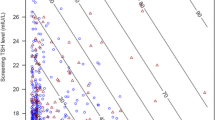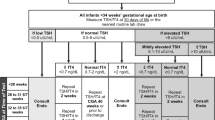Abstract
It is the purpose of this article to briefly review the initial development and subsequent evolution of newborn screening programs to detect infants with congenital hypothyroidism (CH) and then to provide an update of the advantages and disadvantages of the main test strategies. Pilot programs began screening newborn populations in North America in the mid-1970s using either primary thyroxine (T4)-follow-up thyroid stimulating hormone (TSH) or primary TSH testing. Many programs in the United States and around the world continue to prefer a primary T4-follow-up TSH test strategy. This approach has the advantage of detecting infants with primary CH, as well as cases of hypopituitary hypothyroidism, by follow-up of infants with a T4 below an absolute cutoff or with a persistently low T4 level, necessitating a higher recall rate. With increasing assay sensitivity and specificity, several programs in the United States and worldwide have elected to switch to a primary TSH test strategy. This test strategy has the advantage of detecting primary CH and subclinical hypothyroidism and at a lower recall rate. Programs considering switching to a primary TSH test strategy need to develop age-related TSH cutoffs to maintain an acceptable recall rate. Both test strategies have the potential to detect infants with CH characterized by “delayed TSH rise,” but only if they collect a routine or discretionary second specimen, now recommended in low-birth-weight and acutely ill infants. Lastly, a lower TSH cutoff appears to be one of the explanations for the recently described increased incidence of CH.



Similar content being viewed by others
Abbreviations
- CH:
-
Congenital hypothyroidism
- DBS:
-
Dried blood spot
- NNSGRC:
-
National Newborn Screening and Genetics Resource Center
- SCH:
-
Subclinical hypothyroidism
- T3:
-
Triiodothyronine
- T4:
-
Thyroxine
- TBG:
-
Thyroxine-binding globulin
- TSH:
-
Thyroid stimulating hormone
References
Alm J, Hagenfeldt L, Larsson A, Lundberg K (1984) Incidence of congenital hypothyroidism: retrospective study of neonatal laboratory screening versus clinical symptoms as indicators leading to diagnosis. Br Med J 289:1171–1175
Chiesa A, Prieto L, Papendieck P, Gilligan G, Niremberg M, Gruneiro-Papendieck L (2009) Characterization of thyroid disorders found by primary congenital hypothyroidism (CH) neonatal screening: Something is changing? Revi Invest Clin 61(Suppl 1):30
Corbetta C, Webert G, Cortinovis F et al (2009) A 7-year experience with low blood TSH cutoff levels for neonatal screening reveals an unsuspected frequency of congenital hypothyroidism (CH). Clin Endocrinol 71:739–745
Delange F, Camus M, Winkler M, Dodion J, Ermans AM (1977) Serum thyrotropin Determination on day 5 of life as screening procedure for congenital hypothyroidism. Arch Dis Child 52:89–96
Dussault JH, Coulombe P, Laberge C et al (1975) Preliminary report on a mass screening program for neonatal hypothyroidism. J Pediatr 86:670–674
Fisher DA, Dussault JH, Foley TP Jr et al (1979) Screening for congenital hypothyroidism: Results of screening one million North American infants. J Pediatr 94:700–705
Fukushi M, Fujikura K, Hanai J, Yano K, Tamima T, Fujieda K (2009) Neonatal screening for congenital hypothyroidism by measurement of TSH and free T4. Rev Invest Clin 61(Suppl 1):30
Hanna CE, Krainz PL, Skeels MR et al (1986) Detection of congenital hypopituitary hypothyroidism: ten-year experience in the Northwest Regional Screening Program. J Pediatr 109:959–964
Harris KB, Pass KA (2007) Increase in congenital hypothyroidism in New York State and in the United States. Mol Genet Metab 91:268–277
Hunter MK, Mandel SH, Sesser DE, et al. (1998) Follow-up of newborns with low thyroxine and non-elevated thyroid-stimulating hormone-screening concentrations: Results of the 20-year experience in the Northwest Regional Newborn Screening Program. 132:70–74.
Illig R, Torresani T, Sobradillo B (1977) Early detection of neonatal hypothyroidism by serial TSH determination in dried blood. Helv Paediatr Acta 32:289–297
Klein AG, Foley TP Jr (1975) Letter: Screening for hypothyroidism. J Pediatr 87:667–668
Kohler B, Schnabel D, Biebermann H, Gruters A (1996) Transient congenital hypothyroidism and hyperthyrotropinemia: normal thyroid function and physical development at the ages of 6-14 years. J Clin Endocrinol Metab 81:1563–1567
LaFranchi SH, Murphey WH, Foley TP Jr (1979) Neonatal hypothyroidism detected by the Northwest Regional Screening Program. Pediatrics 63:180–191
LaFranchi SH, Hanna CE, Krainz PL, Skeels MR, Miyahira RS, Sesser DE (1985) Screening for congenital hypothyroidism with specimen collection at two time periods: Results of the Northwest Regional Screening Program. Pediatrics 76:734–740
Lanting CI, van Tijn DA, Loeber JG, Vulsma T, de Vijlder JJ, Verkerk PH (2005) Clinical effectiveness and cost-effectiveness of the use of the thyroxine/thyroxine-binding globulin ratio to detect congenital hypothyroidism of thyroidal and central origin in a neonatal screening program. Pediatrics 116(1):168–73
Mandel SJ, Hermos RJ, Larson CA, Prigozhin AB, Rojas DA, Mitchell ML (2000) Atypical Hypothyroidism and the very low birthweight infant. Thyroid 8:693–695
Maniatis AK, Taylor L, Letson GW, Bloch CA, Kappy MS, Zeitler P (2006) Congenital Hypothyroidism and the second newborn metabolic screening in Colorado, USA. J Pediatr Endocrinol Metab 19:31–38
Miyai K, Oura T, Kawashima M, et al. (1978) A new method of paired thyrotropin assay as a screening test for neonatal hypothyroidism. J Clin Endocrinol Metab 47:1028-1033
National Newborn Screening and Genetics Resource Center (NNSGRC), 2009 National Newborn Screening Information System (http://genes-r-us.uthscsa.edu).
Ruiz de Ona C, Obregon MJ, Escobar del Rey F, Morreale de Escobar G (1988) Developmental changes in rat brain 5’-deiodinase and thyroid hormones during the fetal period: the effects of fetal hypothyroidism and maternal thyroid hormones. Pediatr Res 24:588–594
Vulsma T, Gons MH, deVijlder JJM (1989) Maternal-fetal transfer of thyroxine in congenital hypothyroidism due to a total organification defect or thyroid agenesis. N Engl J Med (321):13–16
Wiley V, Bijarnia S, Wikcken B (2009) Screening for hypothyroidism in very low birth weight babies. Rev Invest Clin 61(Suppl 1):31
Author information
Authors and Affiliations
Corresponding author
Additional information
Communicated by: Rodney Pollitt
References to electronic databases:
OMIM #218700, U.S. National Newborn Screening and Genetics Resource Center: http://genes-r-us.uthscsa.edu, United Kingdom UCL Institute of Child Health: http://www.ich.ucl.ac.uk/clinical_information/clinical_guidelines/cmg_guideline_00079
Competing interest: None declared.
Rights and permissions
About this article
Cite this article
LaFranchi, S.H. Newborn screening strategies for congenital hypothyroidism: an update. J Inherit Metab Dis 33 (Suppl 2), 225–233 (2010). https://doi.org/10.1007/s10545-010-9062-1
Received:
Revised:
Accepted:
Published:
Issue Date:
DOI: https://doi.org/10.1007/s10545-010-9062-1




